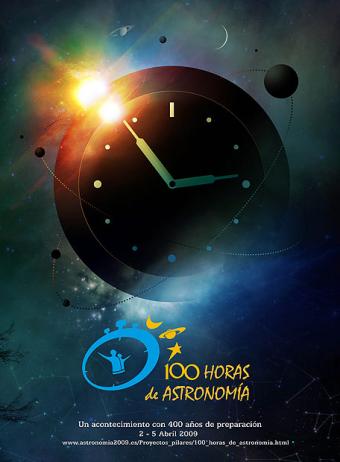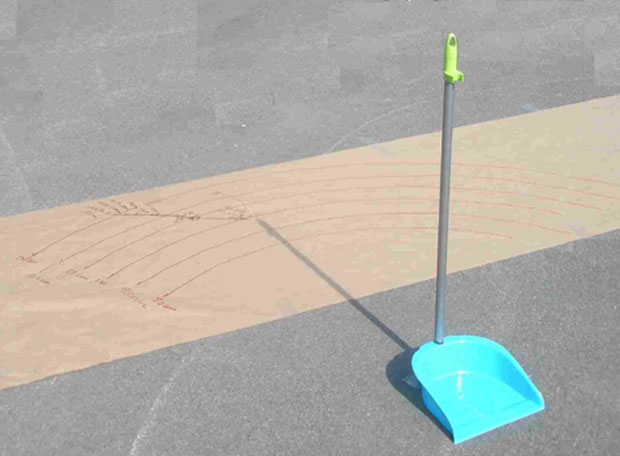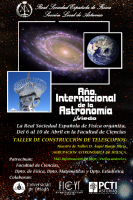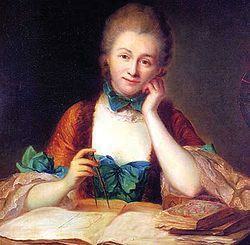En Elpais.com: «Cómo medir el radio de la Tierra con un recogedor»
 Cómo medir el radio de la Tierra con un recogedor
Cómo medir el radio de la Tierra con un recogedor
Alumnos de 800 centros de educación Primaria y Secundaria en toda España repetirán el 26 de marzo el experimento con el que Eratóstenes determinó, hace más de dos mil años, el radio del globo terráqueo
Pere Closas / Emilio J. García 23/03/2009
Granada. 26 de marzo de 2009. Instituto de Educación Secundaria Padre Suárez. En torno al mediodía. En el patio del colegio, un grupo de unos veinte chicos se agolpa frente a la sombra que un recogedor proyecta sobre un papel para embalar extendido sobre el pavimento. De vez en cuando, uno de ellos mira un reloj y grita a viva voz la hora que este marca: «¡Doce y quince minutos!». Al instante, otro de ellos señala con rotulador la punta de la sombra que el recogedor hace sobre el papel. La misma escena se repite en un colegio de Primaria en Cuenca, y en otro centro de un pueblecito de La Palma, y así hasta varios centenares de institutos y colegios repartidos por todo el territorio nacional. ¿Se ha apoderado una extraña fiebre contagiosa de nuestros alumnos y estudiantes más jóvenes? No, simplemente están haciendo Ciencia.
Alejandría. Año 240 antes de Cristo. Al mediodía del solsticio de verano. El bibliotecario de la legendaria biblioteca de Alejandría observa fascinado cómo una vara clavada en la tierra proyecta una larga sombra. Se llama Eratóstenes y acaba de descubrir que la Tierra es necesariamente redonda, y cómo determinar su radio.
El proyecto
El próximo jueves 26 de marzo tendrá lugar uno de los momentos más esperados dentro del Año Internacional de la Astronomía 2009 en España (AIA-IYA2009). Se trata de La Medida del Radio de la Tierra, un proyecto cuyo objetivo es que miles de estudiantes de toda España participen en un gran experimento científico conjunto: repetir el método que ideó, hace más de 2.300 años, Eratóstenes para obtener el radio de la Tierra.
Cuenta la leyenda que Eratóstenes supo de un lugar llamado Siena (la actual Asuán, en Egipto), donde al mediodía del solsticio de verano, el Sol se reflejaba totalmente en las aguas de un profundo pozo, y ninguna vara ni objeto alguno daba sombra. Este fenómeno sólo era posible si, dicho día y a esa hora, los rayos del Sol caían en Siena completamente perpendiculares al suelo.
En cambio, Eratóstenes observó que esto no ocurría en Alejandría, es decir, al mediodía del solsticio de verano, un palo -un gnomon- clavado en la tierra proyectaba sombra y ningún pozo reflejaba totalmente el Sol. Esta diferencia entre ambos lugares, solo podía ser explicada si la Tierra no era plana. Además, el sabio griego ideó un método geométrico muy sencillo, pero muy avanzado en su época, para determinar el radio del globo terráqueo.
De manera muy resumida, este método se basa en la proporción de dos medidas tomadas en el mismo instante por dos observadores separados una gran distancia: una angular (diferencia de altura del Sol en el momento del tránsito por el meridiano) y otra lineal (que puede ser la distancia entre los observadores o la distancia de cada uno de ellos a una referencia común).
La experiencia
 Con la ayuda de los profesores, los alumnos participarán en una adaptación de este método. Para ello deberán situar en algún lugar plano y con buen Sol, un gnomon, es decir, un palo, una vara o un simple recogedor de polvo, y registrar la evolución de su sombra durante varias horas a lo largo de la mañana. Este registro permitirá a los alumnos obtener el primer dato necesario para participar en el proyecto: la altura del Sol en el momento del paso por el meridiano.
Con la ayuda de los profesores, los alumnos participarán en una adaptación de este método. Para ello deberán situar en algún lugar plano y con buen Sol, un gnomon, es decir, un palo, una vara o un simple recogedor de polvo, y registrar la evolución de su sombra durante varias horas a lo largo de la mañana. Este registro permitirá a los alumnos obtener el primer dato necesario para participar en el proyecto: la altura del Sol en el momento del paso por el meridiano.
El segundo dato necesario es una distancia lineal. En el caso de que sólo hubiera dos observadores se necesitaría la distancia entre ambos. La tradición dice que Eratóstenes estimó esta medida enviando a un esclavo a recorrer el camino en línea recta de Alejandría a Asuán contando los pasos. Para la experiencia del 26 de marzo basta con que cada centro comunique su distancia en kilómetros al paralelo 40° N, tomando distancias positivas hacia el Norte y negativas hacia el Sur.
Con las medidas de todos los participantes (varios centenares) y con un cálculo de ajuste estadístico se obtendrá un único valor de la circunferencia y del radio de la Tierra. Este cálculo conjunto permitirá obtener una mejor precisión en el resultado final, pero sobre todo hacer partícipes a nuestros alumnos y alumnas del método científico, y despertar en ellos el sentimiento de que la ciencia es una experiencia colectiva en la que todos ponen su grano de arena.
Ya hay más de 800 centros inscritos por toda España. Será la celebración de un día de fiesta de la ciencia alrededor de un instrumento de la máxima sencillez: un palo, que un grupo de alumnos y profesores han plantado en un rincón del patio y que hace sombra.
Pere Closas es miembro de la Asociación Aster de Barcelona) / Emilio J. García pertenece al Instituto de Astrofísica de Andalucía IAA-CSIC
Taller de Construcción de Telescopios
En Conmemoración del Año Internacional de la Astronomía, la Sección Local de la RSEF en Asturias organiza:
TALLER DE CONSTRUCCIÓN DE TELESCOPIOS NEWTONIONANOS
 Inauguración Lunes 6 de abril a las 9:30 horas en la Sala de Grados de la Facultad de Ciencias de la Universidad de Oviedo
Inauguración Lunes 6 de abril a las 9:30 horas en la Sala de Grados de la Facultad de Ciencias de la Universidad de Oviedo
=====================
PLAZAS AGOTADAS
=====================
Lugar: Facultad de Ciencias
Fechas: del 6 al 10 de Abril de 2009
Número de plazas: limitadas.
Cuota de Inscripción: 50€
Fecha límite para la inscripción: viernes 3 de Abril
Patrocinan: Facultad de Ciencias y los Departamentos de Física, Matemáticas y Estadística.
Colaboran: Universidad de Oviedo y PCTI del Principado de Asturias
Conferencias en el Año Internacional de la Astronomía
Les informamos que con motivo del Año Internacional de la Astronomía, el Grupo de Astronomía de la Facultad de Ciencias de la UNED ha organizado, entre otras muchas actividades, un interesante ciclo de conferencias:
==========================================================
Título: Rayos cósmicos de ultra-alta energía: las partículas más energéticas de la naturaleza.
Conferenciante: Fernando Arqueros Martínez
Fecha: 25 de marzo, miércoles, a las 12:00 h.
Lugar: Salón de Actos de la Facultad de Ciencias Económicas y Empresariales de la UNED. Paseo Senda del Rey, 11. 28040-Madrid.
==========================================================
Título: Lo que sabemos del Universo
Conferenciante: Antonio Fernández-Rañada, Presidente de la Real Sociedad Española de Física.
Fecha: 25 de febrero, miércoles, a las 12:00 h.
Lugar: Salón de Actos de la Facultad de Ciencias Económicas y Empresariales de la UNED. Paseo Senda del Rey, 11. 28040-Madrid.
«Se aplicarán las ideas básicas de la concepción actual del universo, especialmente la teoría del Big Bang y la evolución cósmica. Se examinará la posibilidad de vida extraterrestre, exponiendo los argumentos a favor y en contra. También se tratará sobre el proceso de aparición de la materia, con las dos síntesis de núcleos atómicos o nucleosíntesis, la primordial y el estelar. Finalmente se expondrán los resultados más recientes de la misión WMAP sobre lo que hay en el universo, materia ordinaria y oscura y materia oscura.»
==========================================================
Puedes verlo a través de internet desde aquí.
Preparing high-school physics teachers
Preparing high-school physics teachers
Theodore Hodapp, Jack Hehn, and Warren Hein
Phys. Today 62, 40 (2009)
http://dx.doi.org/10.1063/1.3086101
High-school teachers are one of the most important factors in developing the science and technology workforce of the future. Institutions of higher learning in the US will need to dramatically increase the number of high-school physics teachers they educate if every high-school student who wants to take a physics course is to have access to a highly qualified teacher. The responsibility for that teacher preparation cannot be left solely to education departments or schools of education; we physicists must work with our colleagues in education to address the significant shortage of qualified physics teachers.
Many of the more than 23 000 US high-school physics teachers are not adequately prepared to teach the subject. Only one-third of them, for example, majored in physics or physics education. Poor teacher preparation denies students access to a quality education in the physical sciences. Moreover, students without access to a good high-school physics course are often unprepared for introductory college physics. Physics once attracted the best undergraduates, but now other options seem more attractive. Quantitative indicators are down too. Physics majors now represent only about 1.4% of all science and math undergraduates; 40 years ago the number was 4%.
To improve physics teacher education, the American Physical Society (APS), the American Institute of Physics (AIP), and the American Association of Physics Teachers (AAPT) jointly created the Physics Teacher Education Coalition (http://www.phystec.org) in 1999. Funded primarily by NSF and the APS 21st Century Campaign, PhysTEC has been working closely with about a dozen colleges and universities—and more broadly with a larger coalition of institutions—to identify and disseminate effective practices and innovative methods and to advocate for an enhanced role of physics departments in the education of future teachers.
The number of highly qualified teachers educated at PhysTEC institutions has substantially increased over the past eight years. From our experience in PhysTEC and from visits to successful programs around the country, we are excited to report a number of ideas for helping physics departments to improve the education of future teachers. We include examples and offer suggestions for direct action.
Artículo completo en: http://link.aip.org/journals/doc/PHTOAD-ft/vol_62/iss_2/40_1.shtml
December 1706: Birth of Émilie du Châtelet
 Émilie du Châtelet, famous for being Voltaire’s mistress, was actually a talented scientist and intellectual in her own right. Overcoming challenges that kept women from becoming scientists at the time, she educated herself and carried out experiments in physics, and completed a translation and commentary on Newton’s Principia.
Émilie du Châtelet, famous for being Voltaire’s mistress, was actually a talented scientist and intellectual in her own right. Overcoming challenges that kept women from becoming scientists at the time, she educated herself and carried out experiments in physics, and completed a translation and commentary on Newton’s Principia.
Gabrielle Émilie le Tonnelier de Breteuil (later Émilie du Châtelet), was born December 17, 1706 in Paris. Her father, Louis Nicolas le Tonnelier de Breteuil, was a high ranking official of the court of Louis XIV. The de Breteuil family was part of French aristocratic society, and as such they entertained often. Distinguished scientists and mathematicians were frequent visitors to the household.
Educated at home, the young Émilie learned to speak six languages by the time she was twelve, and had lessons in fencing and other sports. Even from a young age she was fascinated most by science and math, much to her mother’s displeasure. Such interests were not viewed as proper for young ladies, and her mother even threatened to send her away to a convent. Fortunately, her father recognized her intelligence and encouraged her interests, arranging for her to discuss astronomy with prominent scientists he knew.
Émilie also had a flair for gambling, applying her talent at mathematics to give herself an advantage. She used her winnings to buy books and laboratory equipment for her scientific investigations.
When she reached age 18, she knew she had to get married, and she accepted the proposal of Marquis Florent-Claude du Châtelet, a distinguished army officer. This was a convenient arrangement for Émilie, because Châtelet was often away from home, leaving her free to indulge her interests in studying math and science on her own.
She was also free to carry on an affair with the writer Voltaire, one of the few men who appreciated her intelligence and encouraged her scientific pursuits. Émilie du Châtelet and Voltaire renovated Châtelet’s large estate house in the countryside. The house included several rooms for scientific equipment and space for experiments, and a large library holding over 20,000 books, more than many universities at the time.
Although she was frustrated at being excluded from scientific society and education because she was a woman, she was able to learn mathematics and science from several renowned scholars, including Pierre-Louis Maupertuis and Samuel Konig, by inviting them to her house.
In 1737, after several months of conducting research in secret, she entered a contest sponsored by the French Academy of Sciences on the nature of light, heat and fire, submitting her paper Dissertation sur la nature et la propagation du feu. In it she suggested that different colors of light carried different heating power and anticipated the existence of what is now known as infrared radiation. She did not win the contest, but her paper was published and was positively received by the scientific community.
She also developed a strong interest in the work of Isaac Newton, which was somewhat controversial at the time in France, where Cartesian philosophy was favored over Newton’s ideas. Émilie and Voltaire jointly wrote a book, Elements of Newton’s Philosophy, which explained Newton’s astronomy and optics in a clear manner for a wide French readership. Only Voltaire’s name appeared on the book, but he acknowledged her important role.
Émilie also worked on another manuscript, Foundations of Physics, in which she considered the philosophical basis of science and tried to integrate the conflicting Newtonian, Cartesian, and Leibnizian views.
One of her most important contributions to science was her elucidation of the concepts of energy and energy conservation. Following experiments done earlier by Willem ‘s Gravesande, she dropped heavy lead balls into a bed of clay. She showed that the balls that hit the clay with twice the velocity penetrated four times as deep into the clay; those with three times the velocity reached a depth nine times greater. This suggested that energy is proportional to mv2, not mv, as Newton had suggested.
While conducting her scientific work, Émilie du Châtelet still carried out her duties as a mother to her three children and as a hostess for her many visitors so she was always busy, and had little time for sleep.
At age 42 Émilie du Châtelet discovered she was pregnant. At that time, a pregnancy at such an old age was extremely dangerous. Knowing she would likely die, she began working 18 hours a day to complete her biggest project, a French translation of Newton’s Principia, before she died.
More than simply a translation, Émilie du Châtelet’s Principia included her own notes, examples, derivations, and clarifications of Newton’s often obscure writing, as well as examples of experiments that confirmed Newton’s theories. Her modern notation and clear style soon helped French scientists understand and build upon Newton’s ideas.
With determined effort, she achieved her goal of finishing the manuscript just before she died in September 1749. The complete work was published ten years later, when the return of Halley’s Comet brought about a renewed interest in Newtonian mechanics.
Émilie du Châtelet’s book was for many years the only available translation of Newton’s Principia into French, and the translation and insightful commentary probably helped advance science in France. Nonetheless, Émilie du Châtelet herself was largely forgotten by history (or remembered mainly as Voltaire’s mistress) and only recently have her scientific achievements been brought to light.
Physics History
This Month in Physics History – APS News Archives
Historic Sites Initiative – Locations and details of historic physics events
Información sobre la fase Local de la Olimpiada de Física 2009
La Fase Local de la Olimpiada de Física del Principado de Asturias ha tenido lugar el sábado, 21 de marzo de 2009, en las aulas de la Facultad de Ciencias, de la calle Calvo Sotelo de Oviedo.
Ya están disponibles la clasificación final, el examen propuesto y su resolución, en nuestra área de descargas y a continuación:
- [download id=»7″ format=»2″]
- [download id=»8″ format=»2″]
- [download id=»9″ format=»2″]
